- Main Pump Station
 Raw wastewater (sewage) flows by gravity sewer pipelines, from parts of 10 different municipalities, into the Main Pump Station where the volume of water is continuously measured by a flow meter. An automated Fine Screen removes non-biodegradable debris. Four submersible pumps, each capable of pumping 5 MGD, then pump the wastewater uphill for grit and grease removal.
Raw wastewater (sewage) flows by gravity sewer pipelines, from parts of 10 different municipalities, into the Main Pump Station where the volume of water is continuously measured by a flow meter. An automated Fine Screen removes non-biodegradable debris. Four submersible pumps, each capable of pumping 5 MGD, then pump the wastewater uphill for grit and grease removal.
The Grit and Grease Removal Unit is a physical process that allows the heaviest material, (mainly grit) to settle to the bottom of the tank. Diffused air is pumped into the tank, which causes any floatable material (mainly grease) to float up on one side of the tank. The combination of diffused air and rapid velocity keeps all other bio-degradable waste material in suspension for further treatment. Both the grit, and the grease, are automatically removed from the tank, de-watered, and transferred to a dumpster for disposal.
- Equalization Basins
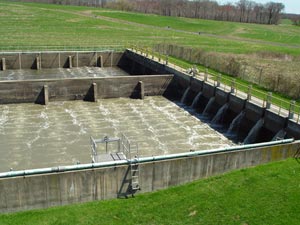 Wastewater then flows to the Equalization Basins, where it is stored for a period of time to equalize the normal daily flow fluctuations. Diffused air is pumped in to keep the wastewater fresh and keep solids in suspension. The wastewater flows out from here at a constant rate to the Oxidation Ditch. The Basins also provide over 1.5 million gallons of storage capacity for excessively high flows during wet weather.
Wastewater then flows to the Equalization Basins, where it is stored for a period of time to equalize the normal daily flow fluctuations. Diffused air is pumped in to keep the wastewater fresh and keep solids in suspension. The wastewater flows out from here at a constant rate to the Oxidation Ditch. The Basins also provide over 1.5 million gallons of storage capacity for excessively high flows during wet weather.
- The Oxidation Ditch
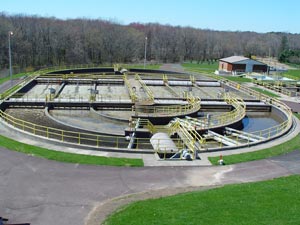 The Oxidation Ditch is a modified version of the activated sludge process, similar to extended aeration. Its tanks are arranged in three, aerated, complete-mix, concentric rings that are designed to reduce Suspended Solids and BOD levels up to 95% and Total Nitrogen and Phosphorus removals up to 80%. Oxidation of ammonia is accomplished in excess of 95%.
The Oxidation Ditch is a modified version of the activated sludge process, similar to extended aeration. Its tanks are arranged in three, aerated, complete-mix, concentric rings that are designed to reduce Suspended Solids and BOD levels up to 95% and Total Nitrogen and Phosphorus removals up to 80%. Oxidation of ammonia is accomplished in excess of 95%.
In the Oxidation Ditch, various microorganisms metabolize (feed on), and biologically flocculate (clump together) the organic pollutants. This biological processing of the waste organics results in a build-up of a microbial mass (activated sludge) in the system, the amount of which is maintained at the most optimum level to achieve the desired treatment. The system has a long detention time (over 12 hours) and passes the microorganisms rapidly through alternating aerobic and anoxic (no free oxygen) zones, thus achieving biological nutrient (nitrogen and phosphorus) removal.
- Final Clarifier Tank
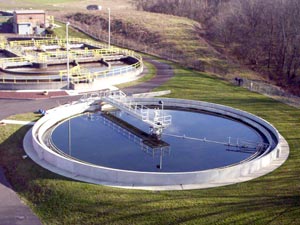 After aeration in the Oxidation Ditch, the wastewater/activated sludge mixture (called mixed liquor) moves downstream to the Final Clarifier Tank. The activated sludge portion of the mixture is allowed to settle by gravity in the circular tank with a detention time of about 4 hours. Ferrous chloride and polymer are added to aid flocculation and settling, and to achieve phosphorus removal. Settled activated sludge is returned by pumps to the Oxidation Ditch to maintain the continuous cycle of activated sludge in the system.
After aeration in the Oxidation Ditch, the wastewater/activated sludge mixture (called mixed liquor) moves downstream to the Final Clarifier Tank. The activated sludge portion of the mixture is allowed to settle by gravity in the circular tank with a detention time of about 4 hours. Ferrous chloride and polymer are added to aid flocculation and settling, and to achieve phosphorus removal. Settled activated sludge is returned by pumps to the Oxidation Ditch to maintain the continuous cycle of activated sludge in the system.
- Ultraviolet Disinfection System
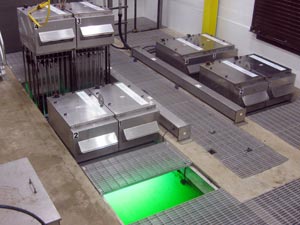 The clarified effluent flows from the Final Clarifier Tank to the Ultraviolet Disinfection System for its final treatment. Here the effluent is exposed to high intensity ultraviolet light for the destruction of any remaining pathogenic (disease-causing) organisms. The flow is then metered and receives final aeration by flowing down a Cascade. The effluent is then discharged to the Neshaminy Creek.
The clarified effluent flows from the Final Clarifier Tank to the Ultraviolet Disinfection System for its final treatment. Here the effluent is exposed to high intensity ultraviolet light for the destruction of any remaining pathogenic (disease-causing) organisms. The flow is then metered and receives final aeration by flowing down a Cascade. The effluent is then discharged to the Neshaminy Creek.
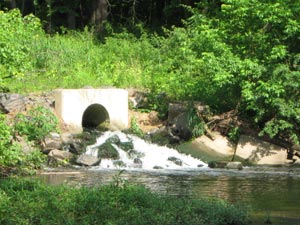
- Laboratory
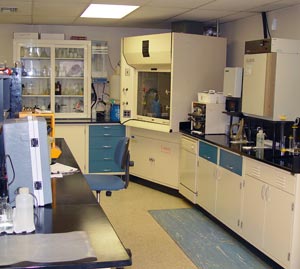 The Facility’s Laboratory analyses the influent, effluent and unit processes, on a daily basis, to ensure the required quality of treatment.
The Facility’s Laboratory analyses the influent, effluent and unit processes, on a daily basis, to ensure the required quality of treatment.

 Raw wastewater (sewage) flows by gravity sewer pipelines, from parts of 10 different municipalities, into the Main Pump Station where the volume of water is continuously measured by a flow meter. An automated Fine Screen removes non-biodegradable debris. Four submersible pumps, each capable of pumping 5 MGD, then pump the wastewater uphill for grit and grease removal.
Raw wastewater (sewage) flows by gravity sewer pipelines, from parts of 10 different municipalities, into the Main Pump Station where the volume of water is continuously measured by a flow meter. An automated Fine Screen removes non-biodegradable debris. Four submersible pumps, each capable of pumping 5 MGD, then pump the wastewater uphill for grit and grease removal. Wastewater then flows to the Equalization Basins, where it is stored for a period of time to equalize the normal daily flow fluctuations. Diffused air is pumped in to keep the wastewater fresh and keep solids in suspension. The wastewater flows out from here at a constant rate to the Oxidation Ditch. The Basins also provide over 1.5 million gallons of storage capacity for excessively high flows during wet weather.
Wastewater then flows to the Equalization Basins, where it is stored for a period of time to equalize the normal daily flow fluctuations. Diffused air is pumped in to keep the wastewater fresh and keep solids in suspension. The wastewater flows out from here at a constant rate to the Oxidation Ditch. The Basins also provide over 1.5 million gallons of storage capacity for excessively high flows during wet weather. The Oxidation Ditch is a modified version of the activated sludge process, similar to extended aeration. Its tanks are arranged in three, aerated, complete-mix, concentric rings that are designed to reduce Suspended Solids and BOD levels up to 95% and Total Nitrogen and Phosphorus removals up to 80%. Oxidation of ammonia is accomplished in excess of 95%.
The Oxidation Ditch is a modified version of the activated sludge process, similar to extended aeration. Its tanks are arranged in three, aerated, complete-mix, concentric rings that are designed to reduce Suspended Solids and BOD levels up to 95% and Total Nitrogen and Phosphorus removals up to 80%. Oxidation of ammonia is accomplished in excess of 95%. After aeration in the Oxidation Ditch, the wastewater/activated sludge mixture (called mixed liquor) moves downstream to the Final Clarifier Tank. The activated sludge portion of the mixture is allowed to settle by gravity in the circular tank with a detention time of about 4 hours. Ferrous chloride and polymer are added to aid flocculation and settling, and to achieve phosphorus removal. Settled activated sludge is returned by pumps to the Oxidation Ditch to maintain the continuous cycle of activated sludge in the system.
After aeration in the Oxidation Ditch, the wastewater/activated sludge mixture (called mixed liquor) moves downstream to the Final Clarifier Tank. The activated sludge portion of the mixture is allowed to settle by gravity in the circular tank with a detention time of about 4 hours. Ferrous chloride and polymer are added to aid flocculation and settling, and to achieve phosphorus removal. Settled activated sludge is returned by pumps to the Oxidation Ditch to maintain the continuous cycle of activated sludge in the system. The clarified effluent flows from the Final Clarifier Tank to the Ultraviolet Disinfection System for its final treatment. Here the effluent is exposed to high intensity ultraviolet light for the destruction of any remaining pathogenic (disease-causing) organisms. The flow is then metered and receives final aeration by flowing down a Cascade. The effluent is then discharged to the Neshaminy Creek.
The clarified effluent flows from the Final Clarifier Tank to the Ultraviolet Disinfection System for its final treatment. Here the effluent is exposed to high intensity ultraviolet light for the destruction of any remaining pathogenic (disease-causing) organisms. The flow is then metered and receives final aeration by flowing down a Cascade. The effluent is then discharged to the Neshaminy Creek.
 The Facility’s Laboratory analyses the influent, effluent and unit processes, on a daily basis, to ensure the required quality of treatment.
The Facility’s Laboratory analyses the influent, effluent and unit processes, on a daily basis, to ensure the required quality of treatment.